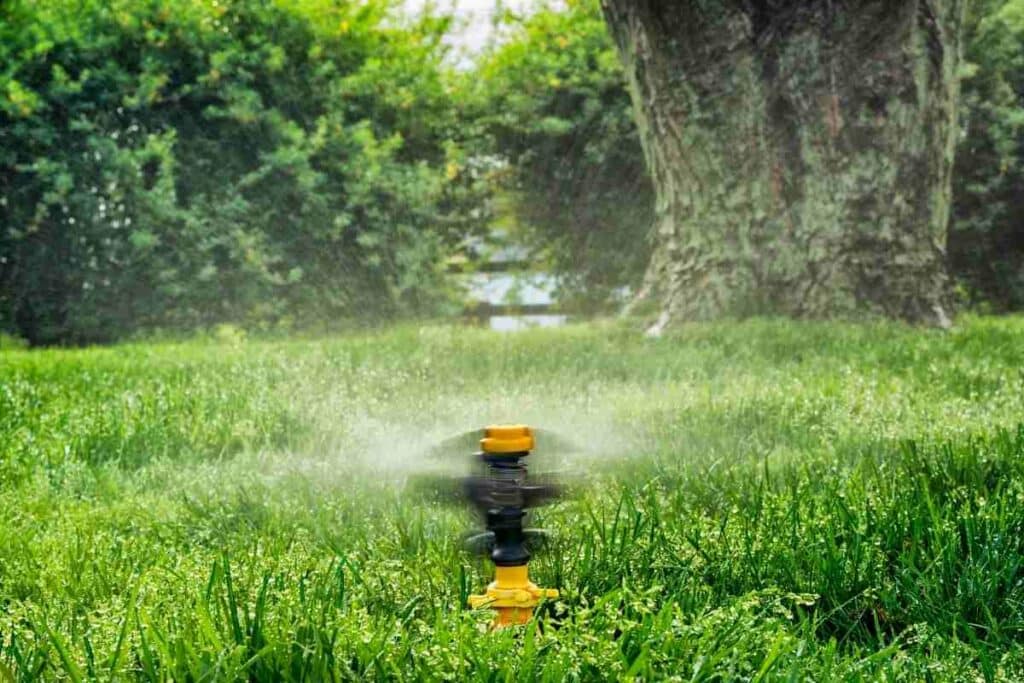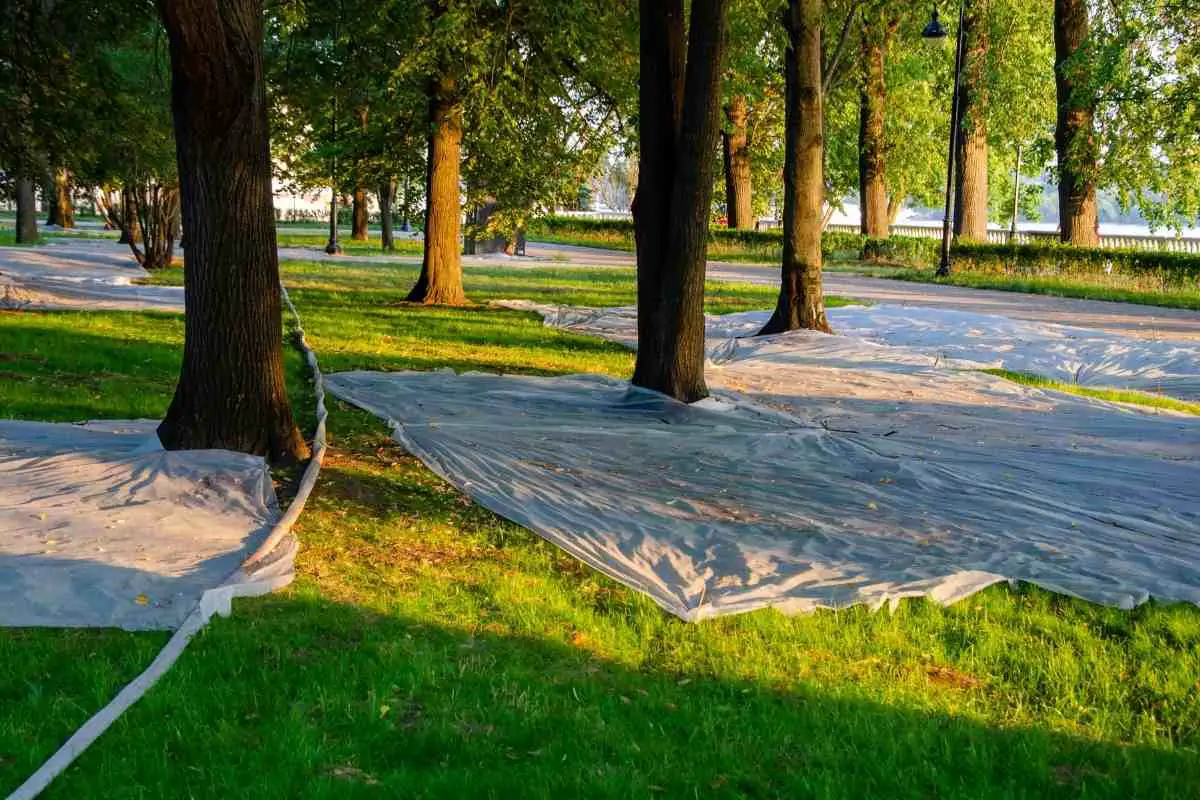Many bird species see grass seeds as an excellent food source and will swoop in for a feast any chance they get. Even if they don’t eat the seeds, they love to take a nice dirt bath on your newly raked ground.
After all the hard work you’ve put in on your lawn, we’re sure you wish they’d just stay away once and for all.
So, let’s go over how you can keep the birds at bay.
Short Answer
To stop birds from eating your grass seeds, there’s a variety of solutions to choose from. For one, you can cover the lawn with different methods, such as netting, mulch, or floating seed covers. Otherwise, you can use noise deterrents, like windchimes or flashy reflective tape, to scare the birds away.
7 Methods to Keep Birds Away From Your Grass Seeds
There are multiple methods used to keep birds from eating your newly sown grass seeds. No matter which way you choose to take, you should rake your seeds up to ⅛ of an inch under the soil. Let’s cover the 7 methods you should consider.
1. Cover Grass Seeds
Sometimes, merely covering your seeds is all it takes to keep the birds away. There are various options when choosing to protect your grass seeds, which we will discuss below.
Mulch
Mulch is an effortless and efficient way of keeping birds off your lawn. Mulch can be any material that is spread or laid over the surface as a way to cover and protect your lawn.
Straw is an excellent choice because it allows water and light to reach the grass seeds.
Also, you’ll want to scatter the mulch to make about 25 percent of the soil visible. Later on you can rake it up when the grass grows because birds lose interest once the grass has sprouted.
This option may not be ideal for you if you live in a particularly windy area.
Repellant Net
You can use either grass seed netting, floating seed cover, or bird repellent netting. We recommend that you use stakes in the ground or stones to keep it in place throughout windy nights.
Moreover, the netting material should be light and can be placed directly on the sown soil. But to prevent birds from pecking through the holes, you can raise the netting 2 or 3 inches above the ground.
Thanks to its lightness, it won’t retain moisture or grow mildew and mold. Then, once the seeds take root and grow well, you can remove the netting.
Burlap
Burlap is another option for those that get a fair amount of wind on their property. It’ll stay down with the proper weights. Like the other options, burlap lets in the light, water, and heat, which are essential to the seeds.
2. Add Fake Predators
Many have found success in using fake owls, hawks, or even dogs around their yard to keep smaller birds away. Birds are smart enough to stay away from predators, even if they can’t distinguish real birds from fake ones.
Additionally, make sure to move it around once in a while so that birds don’t get used to seeing them stationary. Even rubber snakes on the soil can often do the trick and keep the birds away.
3. Use Deterrent
You can use either noise or light deterrent for birds, as both scare them. And feel free to choose the noise or light device least obtrusive to you.
Noise Deterrent
If you have enough wind to produce consistent noise, windchimes can effectively keep your lawn a loud place so that birds feel unsafe in it. However, if you’d prefer no sound, there are ultrasonic devices that are undetectable to human ears as well.
Light Deterrent
Birds are afraid of objects that reflect light, and bird or mylar tape is reflective and makes a humming noise in the breeze. Just attach some to stakes around the yard, 1 or 2 feet apart.
Make sure it isn’t in a shady spot so that it’ll catch the light.
Reflector take is versatile and is available from Amazon.com here
You could also take advantage of cheap pinwheels and put them around the yard. And another easy, affordable option is stringing old CDs together about 1 foot apart.
4. Hang a Decoy Feeder
If you’d still like to see birds around, just not on the ground with your grass seeds, you can hang a decoy feeder. Just be sure to make the seeds in the feeder more appealing than the grass seeds.
To explain, birds can access feeders easier, and they prefer their seeds. You can even take it a step further and research the seeds that the birds in your area like.
However, this will attract more birds, so ensure the feeder is a fair distance away from your grass seeds.
5. Lay Bird Repellent Seeds
There’s an option to buy bird-repellent grass seeds, which is the easiest solution because you don’t have to do much except lay the seeds.
Unfortunately, these bird repellent seeds can still be eaten by birds, but they certainly won’t be their preferred seed choice.
6. Insert a Motion-Activated Sprinkler

This sprinkler will keep your lawn watered and fend off birds from grass seeds. It’ll begin to water the property when it detects any motion or a bird enters the area.
7. Sow Extra Seeds
If there’s no way around the birds eating a few of your grass seeds, you might as well plant plenty to go around.
This won’t only help the bird problem but also ensures enough seeds make contact with the soil and sprout.
We know this isn’t the ideal answer, but if no other options from our list work for you this is likely the best solution.
Bottom Line
Ultimately, because we know that putting all the work into your newly sown grass seeds just to watch it taken away before it’s even sprouted is discouraging, we’ve discussed a variety of methods to keep the birds from eating your grass seeds.
So, find the method that works best for you based on your budget, climate, and lawn to keep your seeds in the ground and the birds at bay.
- Guide To Desert Plants: Types, Adaptations, And Landscaping Tips
- Philodendron Care, Varieties, And Aesthetic Home Arrangements
- Potato Bugs: Identification, Impact, And Control
- What Do Squirrels Eat? A Gardener’s Guide to Squirrel Diets
- Understanding Chipmunks In Your Garden: Behavior, Diet, And Tips For Gardeners
